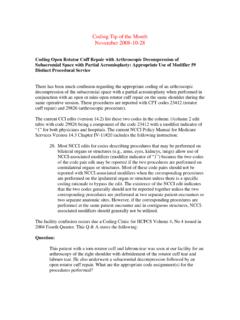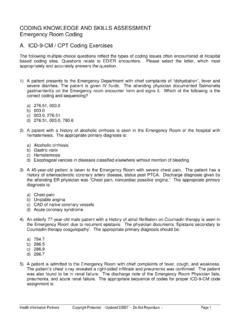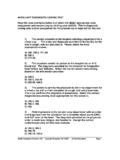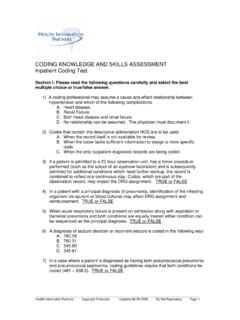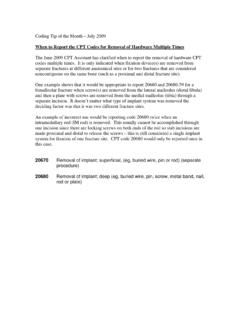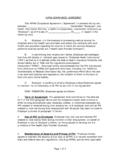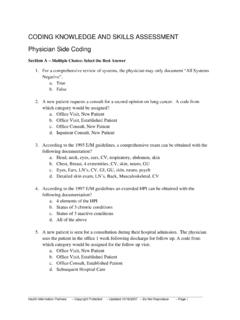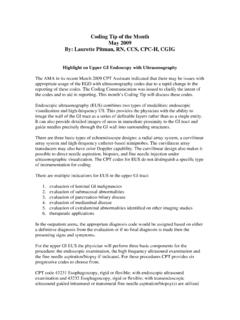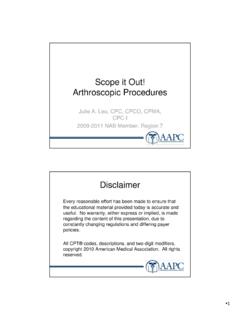Transcription of CODING KNOWLEDGE AND SKILLS ASSESSMENT …
1 CODING KNOWLEDGE AND SKILLS ASSESSMENT . outpatient Surgery and Emergency Room CODING A. ICD-9-CM / CPT CODING Exercises The following multiple-choice questions reflect the types of CODING issues often encountered at hospital based CODING sites. Questions relate to outpatient Surgery and ED/ER encounters. Please select the letter, which most appropriately and accurately answers the question. 1) A 45-year-old patient is taken to the Emergency Room with severe chest pain. The patient has a history of arteriosclerotic coronary artery disease, status post PTCA. Discharge diagnosis given by the attending ER.
2 Physician was Chest pain, noncardiac possible angina. The appropriate primary diagnosis is: a) Chest pain b) Unstable angina c) CAD of native coronary vessels d) Acute coronary syndrome 2) An elderly 77-year-old male patient with a history of atrial fibrillation on Coumadin therapy is seen in the Emergency Room due to recurrent epistaxis. The physician documents Epistaxis secondary to Coumadin therapy coagulopathy'. The appropriate primary diagnosis should be: a) b) c) d) 3) A patient with worsening cough and shortness of breath is sent to the Emergency Room and a chest x-ray is ordered and taken.
3 The radiologist documents Large apical chest wall mass and multiple lung densities, consistent with chest wall malignancy with a lung cancer primary as the impression on the radiology report. The Emergency room physician documents, Chest mass, probable lung cancer . What diagnosis (es) should be reported and the correct sequence: a) , b) , c) d) , , e) , 4) A patient is admitted to the Emergency Room with chief complaints of fever, cough, and weakness. The patient's chest x-ray revealed a right-sided infiltrate and pneumonia was confirmed. The patient was also found to be in renal failure.
4 The discharge note of the Emergency Room Physician lists, pneumonia, and acute renal failure. The appropriate sequence of codes for proper ICD-9-CM code assignment is: a) , 486, b) 486, c) 486, , d) 486, , 5) A patient came to the emergency room with hypotension and tachycardia. Upon exam, the patient's condition was determined to be the result of a tetanus toxoid that was administered four hours earlier. Which of the following is the appropriate sequencing? a) Hypotension; tachycardia; and accidental poisoning due to tetanus toxoid b) Unspecified adverse reaction and undetermined cause E code c) Poisoning due to tetanus toxoid and therapeutic use E code for tetanus toxoid d) Hypotension; tachycardia; and therapeutic use E code for tetanus toxoid Health Information Partners.
5 - Copyright Protected - Revised 2/2007 - Do Not Reproduce - Page 1. 6) The following ICD-9-CM index entries appear: Encephalitis infectious (acute) (virus) NEC postinfectious NEC [ ]. The diagnosis listed by the physician is encephalitis after infection. Which of the following represents the correct CODING and sequencing? a) b) c) ; d) ; 7) Child presents to emergency room accompanied by parents. The patient has a large cm splinter lodged on the sole of his foot superficially, after playing on a wooden floor in his bare feet at home. The physician prepares the area with betadine, and pulls the splinter out with tweezers without making an incision.
6 The appropriate CPT code is: a) An appropriate evaluation/management code for emergency room services. (99185-99285). b) 28190 Removal of foreign body, foot; subcutaneous c) 10120 Incision and removal of foreign body, subcutaneous tissues; simple d) A and B. 8) A patient had a septoplasty, and bilateral submucous resection inferior turbinate. What CPT code or codes would be assigned? a) 30520 and 30930-50. b) 30520 and 30140. c) 30140-50 and 42145. d) 30520 and 30140-50. 9) The patient presented through the ED with severe abdominal pain, amenorrhea. Patient was diagnosed with tubal pregnancy.
7 A unilateral salpingectomy with removal of tubal pregnancy was performed. Which of the following is the correct code assignment? a) , b) , c) , d) , 10) An ambulatory surgery patient had a colonoscopy performed because of intermittent severe constipation. Abdominal ultrasound done one-week prior revealed a possible small mass near the ascending colon. The physician utilized a standard colonoscope to view the entire colon, and then employed an echoendoscope, utilizing a balloon tipped transducer housing to visualize the ascending colon in the area where the suspicious mass and stricture was visualized.
8 The balloon was filled with water, and imaging and dilation of the one area was performed to identify any extrinsic mass, which may have been causing the compression/stricture of the bowel. No extrinsic mass or lesion was visualized to explain the patient's symptoms; therefore further diagnostic treatment was not indicated. The appropriate CPT code(s) for this procedure is: a) 45341 Sigmoidoscopy, flexible; with endoscopic ultrasound examination b) 45391 Colonoscopy, flexible, proximal to splenic flexure; with endoscopic ultrasound examination c) 45378 Colonoscopy, flexible, proximal to splenic flexure; diagnostic with/without collection of specimen (s).
9 By brushing/washing, with/without colon decompression (separate procedure). d) 45386 Colonoscopy, flexible, proximal to splenic flexure; with dilation by balloon, 1 or more strictures Health Information Partners. - Copyright Protected - Revised 2/2007 - Do Not Reproduce - Page 2. 11) A patient had an arthroscopic subacromial decompression of the right shoulder with excision of the right distal clavicle. The appropriate CPT code(s) for this encounter is: a) 29826-RT Shoulder arthroscopy, surgical; decompression of subacromial space partial acromioplasty with/without coracoacromial release b) 23200-RT Radical resection for tumor; clavicle c) 29826-RT Shoulder arthroscopy, surgical; decompression of subacromial space partial acromioplasty with/without coracoacromial release; and 29824-RT Partial excision of distal clavicle d) 23140-RT Excision/curettage of bone cyst/benign tumor of clavicle.
10 E) 23420-RT Reconstruction of complete shoulder (rotator) cuff avulsion, chronic (includes acromioplasty). and claviculectomy. 12) Patient has a diagnosis of deviated septum with nasal deformity bilateral. The patient has ambulatory surgery performed with nasal reconstruction via bilaterally septoplasty with bilateral submucous resection of superior nasal turbinates. The appropriate CPT code(s) for this encounter are: a) 30520-50 Septoplasty or submucous resection, with/without cartilage scoring, contouring or replacement with graft and 30999 Unlisted procedure, nose. b) 30520 Septoplasty or submucous resection, with/without cartilage scoring, contouring or replacement with graft; and 30999-50 Unlisted procedure, nose c) 30520 Septoplasty or submucous resection, with/without cartilage scoring, contouring or replacement with graft.
